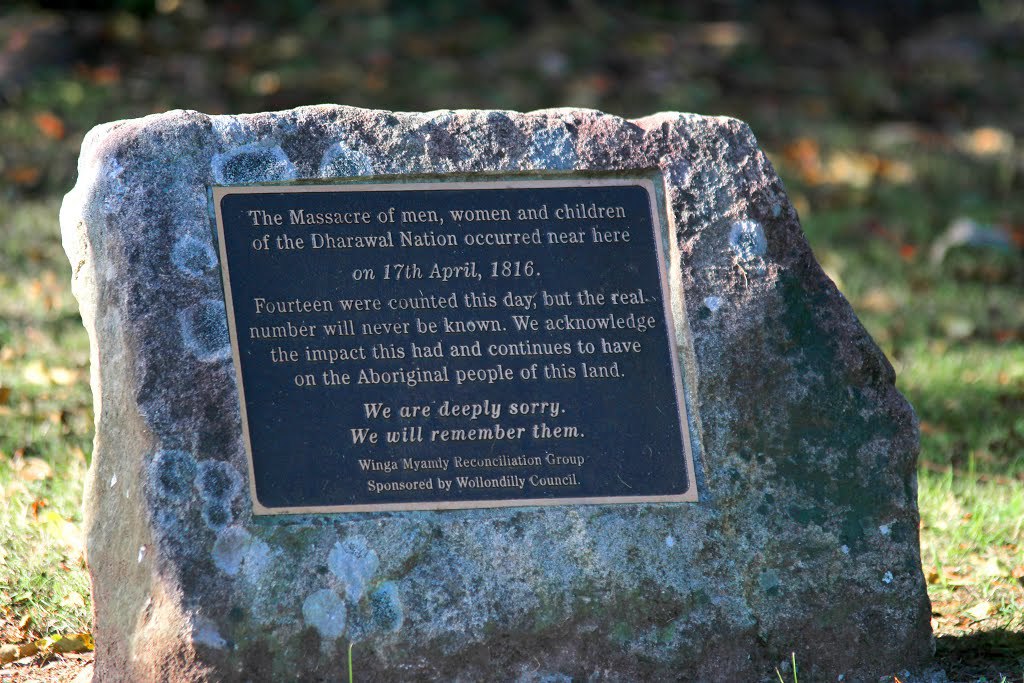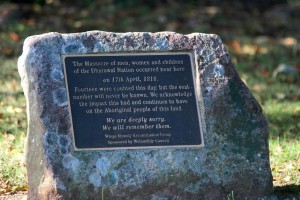
GOOD MONDAY MORNING, P.O.U.!
This week we’ll take a look the various massacres of Aboriginal people that took place in Australia.
THE APPIN MASSACRE OF 1816

Sadistic massacre continues to haunt
Author: Michelle Hoctor
Date: 13/11/2010
Momentum is growing to officially recognise the mass murder of the Dharawal people almost 195 years ago, and for the site to be rehabilitated and restored, writes Michelle Hoctor.
Frances Bodkin is haunted by images of the Aboriginal women, children and elderly people who were herded off cliffs near Appin almost 195 years ago.
The fact that this horrendous act of genocide occurred generations before her birth matters little. These were her people and the trauma has permeated time.
“I won’t go there. I just get horrible pictures of women and children and that is heartbreaking,” she said.
Today, momentum is growing to have the atrocities that took place against the Dharawal people, known as the Appin Massacre of April 17, 1816, officially recognised.
Wollondilly MP Phillip Costa, who outlined the details in NSW Parliament for the first time in May 2008, is calling for the Dharawals to be allowed to return to the Crown lands site.
Ms Bodkin, a direct descendant of Kannabi Byugal, one of 14 men murdered by Governor Lachlan Macquarie’s troops as part of the massacre, wants the area rehabilitated and restored to its original, sacred condition.
The Dharawals were the original inhabitants of the area, but by 1813 much of the land was inhabited by Europeans who referred to it as the Cowpastures.
Mr Costa told Parliament that between 1814 and 1816 relations between the Aborigines and the settlers became tense.
Ms Bodkin, of Tahmoor, said the hostilities escalated over a revenge attack by members of the Gundungurra clan, who were visiting from the Blue Mountains.
“There was a drought in 1813 and, as was the tradition, in drought times the Gundungurra were allowed to come down to the plains. It was an offer of peace and they were our neighbours and they were in trouble,” she said.
“But when they came down, what they found were fences and angry people who didn’t want them on their properties, which confused them.”
Ms Bodkin said in one skirmish, a Gundungurra war leader’s wife and children were murdered.
“Under Gundungurra law, the payback was the same. If somebody murdered your wife, you were allowed to kill their wife. It was a payback, but the white people didn’t understand this.”
In retribution, NSW Governor Lachlan Macquarie commanded his troops to “inflict terrible and exemplary punishments” on the Aborigines by “clearing the country of them entirely, driving them across the mountains”.
But as the troops bore down on the Cowpastures, it rained and, as was the tradition, the Gundungurra returned home. This left the Dharawal people, who lived in peace with the settlers, to pay the price in a tragic case of mistaken identity.
The soldiers progressed to Appin, reaching a Dharawal men’s camp near Broughton Farm at 2am. Fourteen men were killed and beheaded, their heads taken back to Sydney.
Ms Bodkin said that one of the soldiers’ guides, a young Aborigine named Bundle, was able to get away and warn the women and children, who were staying at a separate camp near Broughton Pass.
“As the women and children started to take off, the civilian militia hunted them down and drove them over the cliff.” Others were shot or trampled by horses.
In May this year, Mr Costa said the massacre represented the beginning of a campaign of dislocation, the effects of which some people continued to feel today, as all the leaders of the Dharawal community were killed that morning.
He told the NSW Parliament that the Dharawal needed to be returned to the site to “reverse the impact of the past 200 years”.
Ms Bodkin, an author and teacher of the Dharawal culture, said her community, which includes about 14 descendants of those killed in 1816, hoped to rehabilitate the site.
“We want to return it back to what it was, a beautiful, peaceful place … back to the way it was with the food and the medicine plants,” she said.
A ceremony of remembrance has been held at Cataract Dam for the past decade, initiated by members of the Winga Myamly Minto Reconciliation Group.
NSW Reconciliation Council ambassador Col Markham said Australia’s history was marked by terrible acts of Aboriginal genocide that continued to go unrecognised.
“What happened was absolutely horrific. That human beings could do that to another group of human beings based on a so-called theory of less than human,” he said.
“For the one or two they killed, the retaliation was brutal. Their waterholes were poisoned, their food laced with arsenic. They [Europeans] did all sorts of bloody dreadful things.
“If people in this country really understood what happened over 150 years or more, maybe they’d have a better understanding of some of the major issues that affect Aboriginal people and their communities.”
Mr Markham said that although Governor Macquarie had a history of kindness towards Aborigines, the Appin massacre was a blight on his record.
“If it had happened today, he could have been put on trial for genocide.”
Ms Bodkin said her prevailing feeling was one of sadness.
“I often wonder, if Kannabi had survived and passed down his knowledge, how much more we might have known. When people like that are taken, their knowledge is lost forever.”
(SOURCE: Illawarra Mercury)
